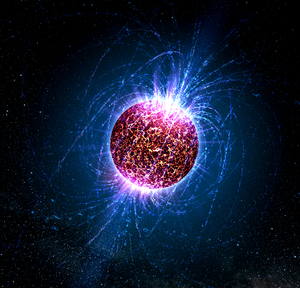Difference between revisions of "Neutron Star"
| (2 intermediate revisions by 2 users not shown) | |||
| Line 7: | Line 7: | ||
: After a [[High Mass Star|high mass star]] has gone [[supernova]] the core which remains is crushed so much that the [[atom]]s [[Nuclear Fusion|fuse]] together and all [[proton]]s turn into [[neutron]]s making one single [[atom]] made of [[neutron]]s. | : After a [[High Mass Star|high mass star]] has gone [[supernova]] the core which remains is crushed so much that the [[atom]]s [[Nuclear Fusion|fuse]] together and all [[proton]]s turn into [[neutron]]s making one single [[atom]] made of [[neutron]]s. | ||
: A '''neutron star''' is around 20km in [[diameter]]. | : A '''neutron star''' is around 20km in [[diameter]]. | ||
| + | |||
| + | ===References=== | ||
| + | ====AQA==== | ||
| + | |||
| + | :[https://www.amazon.co.uk/gp/product/178294558X/ref=as_li_tl?ie=UTF8&camp=1634&creative=6738&creativeASIN=178294558X&linkCode=as2&tag=nrjc-21&linkId=f0dfb66dafcb0c6e9449e7b1a4ae1ac327 ''Neutron stars, page 100, GCSE Physics; The Revision Guide, CGP, AQA ''] | ||
| + | :[https://www.amazon.co.uk/gp/product/1782945970/ref=as_li_tl?ie=UTF8&camp=1634&creative=6738&creativeASIN=1782945970&linkCode=as2&tag=nrjc-21&linkId=a120d24dcc7cc7a58192069a3aafc1d2 ''Neutron stars, page 319, GCSE Physics; The Complete 9-1 Course for AQA, CGP, AQA ''] | ||
| + | :[https://www.amazon.co.uk/gp/product/1471851370/ref=as_li_tl?ie=UTF8&camp=1634&creative=6738&creativeASIN=1471851370&linkCode=as2&tag=nrjc-21&linkId=01c69b0ae058f809cf636033e6ba793e ''Neutron stars, pages 252, 253, GCSE Physics, Hodder, AQA ''] | ||
| + | |||
| + | ====Edexcel==== | ||
| + | |||
| + | :[https://www.amazon.co.uk/gp/product/1292120223/ref=as_li_tl?ie=UTF8&camp=1634&creative=6738&creativeASIN=1292120223&linkCode=as2&tag=nrjc-21&linkId=068ecf40278c32406a7f1c6e66751417 ''Neutron stars, page 123, GCSE Physics, Pearson Edexcel ''] | ||
| + | :[https://www.amazon.co.uk/gp/product/1782948163/ref=as_li_tl?ie=UTF8&camp=1634&creative=6738&creativeASIN=1782948163&linkCode=as2&tag=nrjc-21&linkId=0fdbfd5dd397d6e24a9dfb250f08587f ''Neutron stars, page 188, GCSE Physics, CGP, Edexcel ''] | ||
==Beyond the Curriculum== | ==Beyond the Curriculum== | ||
{{#ev:youtube|https://www.youtube.com/watch?v=fFeV8WxIZLk}} | {{#ev:youtube|https://www.youtube.com/watch?v=fFeV8WxIZLk}} | ||
| + | {{#ev:youtube|https://www.youtube.com/watch?v=ZW3aV7U-aik}} | ||
Latest revision as of 16:03, 23 November 2019
Contents
Key Stage 4

An artist's impression of a neutron star with plasma streaming in arcs due to the extremely intense magnetic field.
Meaning
A neutron star is one of the possible last stages of a high mass star's life in which the core has collapsed so much that it has become a single atom made of only neutrons.
About Neutron Stars
- After a high mass star has gone supernova the core which remains is crushed so much that the atoms fuse together and all protons turn into neutrons making one single atom made of neutrons.
- A neutron star is around 20km in diameter.
References
AQA
- Neutron stars, page 100, GCSE Physics; The Revision Guide, CGP, AQA
- Neutron stars, page 319, GCSE Physics; The Complete 9-1 Course for AQA, CGP, AQA
- Neutron stars, pages 252, 253, GCSE Physics, Hodder, AQA
Edexcel
- Neutron stars, page 123, GCSE Physics, Pearson Edexcel
- Neutron stars, page 188, GCSE Physics, CGP, Edexcel